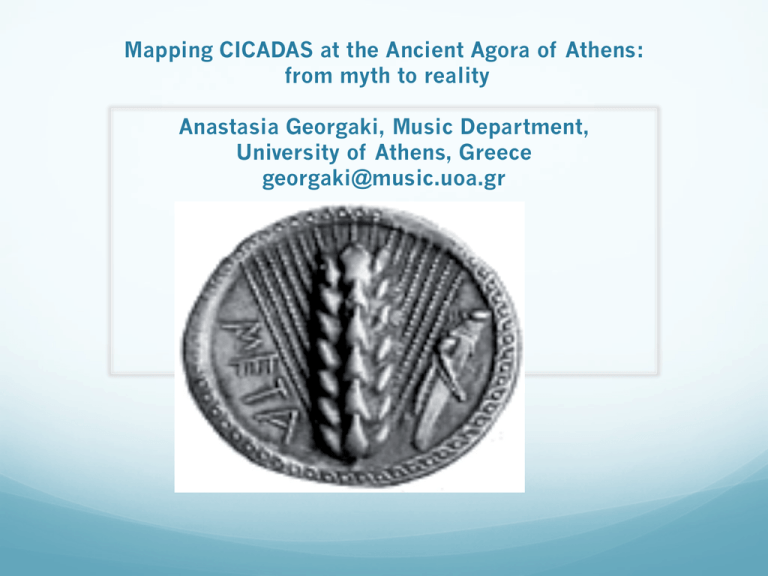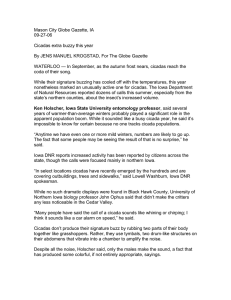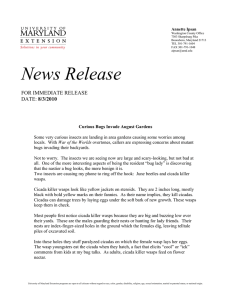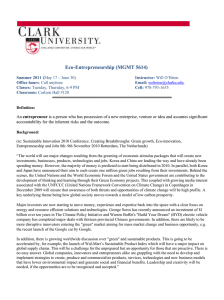Cicada
advertisement

Mapping CICADAS at the Ancient Agora of Athens: from myth to reality Anastasia Georgaki, Music Department, University of Athens, Greece georgaki@music.uoa.gr Overview Greek Tettigology in Poetry and literature (from Ancient to Modern Greece) Allegoric matters on cicada songs Acoustic communication of cicada The cicada Chorus and its Stochastic laws (Xenakis, Mache,etc.) ICADA at the ancient agora (exploring the soundclouds, Creating Stochastic events,) Design of a sound installation Mapping CICADA AT ANCIENT AGORA Eos and Tithonos (a video on the dawn at ancient agora) download from https://www.dropbox.com/s/k3cgfcynky19gbk/Tzitzikia.mpg ON GREEK TETTIGOLOGY Greek Tettigology Homer ( ), lilly-like voice Hesiodos Aesope (working ant, lazy cicada) Tithonus and Eos (Myth) Eunomos (Musician) Anacreon (Poet) Plato (Plato Phdr. 259b5-259d8 ristote (Historia Animalia) Modern Greek Poets (Elytis, Seferis, Ritsos, etc.) TETTI ( 570B.C.) , , ὅτε ἐπ᾽ ἄκρων ὀλίγην ππ βασιλεὺς ὅπ ἀείδειv Allegories on Cicada songs 1. Aesthetic value (resurrection, immortality) 2. Types of call (echemes, phrases, ostinato, chorus, etc.) 3. Distribution of cicadas song (social meanings) 4. Interaction (acoustic communication) Cicada (Cicada plebeia) Cicada ( / téttix Cicada plebeia) Typical song or noise (ἠχεῖν/ cheîn, Hes. Op. 583; Sappho Fr. 89 D.; Anth. Pal. 7,196 and 201) produced by rubbing the wings against the opercula (cf. Aristot. Hist. an. 4,9,535b 7-9) is often the only sound on a hot summer day when all other animals are silent (e.g., Hes. Sc. 396; Aristoph. Av. 1095; Theoc. 5,110 and 7,139; Verg. Ecl. 2,13; G.… http://www.cicadasong.eu/cicadidae/ Cicadatraicari.html Kingdom: Animalia Phylum: Arthropoda Class: Insecta Order: Hemiptera Suborder:Auchenorrhyncha Infraorder:Cicadomorpha Superfamily:Cicadoidea Family: Cicadidae Subfamilies Cicadettinae. Cicadinae, Tettigadinae, Tibiceninae GREEK SPECIES: Cicada orni,alhageos,Cicadatra atra, Cicadatra hyalina, Cicadatra hyalinata and Lyristes plebeius. CICADA SPECIES Cicada species are separated by the following factors (Moore, 1990) Geography Habitat Season (temperature) Diurnal pattern of reproductive activity Acoustic signals Metamorphosis GREEK Cicada http://www.cicadasong.eu/ (Drosopoulos, Gogala, Boulard, Sueuer et al) Cicada orni Cicadatra alhageos Cicadatra atra, Cicadatra hyalina, Cicadatra hyalinata Lyristes plebeius. Cicada orni A typical phrase of cicada Orni CICADA ACOUSTIC SIGNAL T (twitter, Chatter) Kπ- usic traditionelle, Music Byzantine HXEIN (chema) OSTINATO Acoustic range Of cicada Acoustic emission of insects 7=/;/-2/6/ 37=/;?+5 -2/6/ ;8>9809>5</< 6953=>./ ;/:>/7-B C %/+4 0;/:>/7-B 7=/7<3=B* )36/< +55371<87180 $<-35581;+6+6953=>./?<=36/<87+1;+68;<9/-=;81;+60;/:>/7-B?<=36/+7. 6/+7+6953=>./<9/-=;>60;/:>/7-B?<+6953=>./ Typical phrase of cicada orni The Domino Effect Effect Last word Echemes of different Greek Cicadas I A kHz C B 20 15 10 5 1V 0.2 0.4 0.6 0.8 1.0 1.2 s II A kHz C B 20 15 10 5 1V 0.2 0.4 0.6 0.8 1.0 1.2 s III A kHz 20 C B 15 10 5 1V 0.2 0.4 0.6 0.8 1.0 1.2 s 3. Acoustic profiles: I – Cicada cretensis sp. n., male from Chania; II – C. orni, male from Skyros; III – C. mordoganensis, male m Samos. A – oscillogram, B – sonagram, C – amplitude spectrum. Acoustic parametrization of a CICADA ORNI phrase /<-;39=38780=2/+-8><=3-?+;3+,5/<+7+5BC/.08; -+55< *+;3+,5/ /<-;39=387 #880/-2/6/<< -2/6/.>;+=387 7=/;/-2/6/37=/;?+5 -2/6/9/;38. -2/6/37=/;/-2/6/ 37=/;?+5;+=38 %/+40;/:>/7-B "3736>60;/:>/7-B "+A36>60;/:>/7-B +7.@3.=2 &>+;=35/ &>+;=35/ #>6,/;80/5/6/7=<9/;</-87. >;+=38780/+-2/5/6/7=0;86<=+;==8/7.6< >;+=387,/=@//7=2//7.8087//5/6/7=+7.=2/,/137737180=2/08558@37187/6< >;+=387,/=@//7=2/<=+;=8087//5/6/7=+7.=2/,/137737180=2/08558@37187/6< '+=38,/=@//7=2//-2/6/.>;+=387+7.=2/37=/;/-2/6/37=/;?+5 &>+;=35/ &>+;=35/ &>+;=35/ ;/:>/7-B80=2/6+A36>6+6953=>./87=2/<9/-=;>6 !8@/<=0;/:>/7-B2+?371+7+6953=>.//A-//.371=2/=2;/<285. . 312/<=0;/:>/7-B2+?371+7+6953=>.//A-//.371=2/=2;/<285. . 300/;/7-/,/=@//7=2/6+A36>6+7.63736>60;/:>/7-3/<C ;/:>/7-B,/58@@23-280=2/=8=+5/7/;1B80=2/<9/-=;>6;/<3./< ;/:>/7-B,/58@@23-2 80=2/=8=+5/7/;1B80=2/<9/-=;>6;/<3./<6/+70;/:>/7-B80=2/ <9/-=;>6 ;/:>/7-B,/58@@23-280=2/=8=+5/7/;1B80=2/<9/-=;>6;/<3./< 300/;/7-/,/=@//7=2/>99/;:>+;=35/+7.58@/;:>+;=35/:>+;=35/<80=2/<9/-=;>6 +6/+<>;/80=2/9>;/7/<<80=2/<8>7. Acoustic caracteristics of Greek cicada Echemes with 0.22 ± 0.04 s of duration that are separated by intervals of 0.10 ± 0.04 s. With respect to the spectral characteristics of the signal, it shows a peak frequency of about 5.36 ± 0.34 kHz, and a bandwidth (20 dB) of 8.26 ± 0.99 kHz. The mean frequency (quartile 50%) is about 6.12 ± 0.22 kHz and the interquartile range of frequency is relatively small, averaging 2.44 ± 0.29 kHz. The new species can be distinguished acoustically from C. orni and C. mordoganensis by almost all of the investigated variables. Models of cicada distribution macroscopic models: particles of one type are grouped together, only the particle numbers (or the concentrations) are considered, systems are assumed homogeneous Macroscopic models: deterministic models: ordinary differential equation systems stochastic models: the system is modeled as a random process hybrid models: mix of deterministic and stochastic elements “…encourages us to credit the animal with a sense of sound architecture […] . If the bird has the sense of balance between non variation and variation at the level of syntax of sequences, it can also manipulate with order, at the higher level, the temporal proportions of sequences or of the strophes between them. To know if this architecture is itself innate or if it forms part of individual learning, we would need to study for each species a large quantity of analyses which are still far from being achieved. From what I have been able to establish about larks, it seems that the role of ontogenesis, of individual development, may be considerable (Mâche: 1992: 141). Xenakis and the cicadas Everyone has observed the sonic phenomena of a crowd of dozens or hundreds or thousands of people. The human river shouts a slogan in a uniform rhythm. Then another slogan springs from the head of the demonstration; it spreads towards the tail replacing the first. A wave of transformation thus passes from the head to the tail. The clamor fills the city, and the inhibiting force of voice and rhythm reaches a climax. It is an event of great power and beauty in its ferocity. Then the impact between the demonstrators and the enemy occurs. The perfect rhythm of the last slogan breaks up in a huge cluster of chaotic shouts, which also spreads to the tail. Imagine, in addition, the reports of dozens of machine guns and the whistle of bullets adding their punctuations to this total disorder. The crowd is then rapidly dispersed, and after sonic and visual hell follows a detonating calm, full of despair, dust and death. The statistical laws of these events, separated from their political or moral context, are the same as those of the cicadas and the rain. They are the laws of the passage from complete order to total disorder in a continuous or explosive manner. They are stochastic laws. Here we touch on one of the great problems that have haunted human intelligence since antiquity; continuous or discontinuous transformation (from Formalized Music: Thought and Mathematics in Composition, copyright 1955 by the author; published by Indiana University Press, 1971). [Emphasis added.] Mapping the Cicadas at the Ancient Agora 1. Recordings of 5 different areas in different periods (June, July, August and September) 2. Google earth mapping of the cicadas 3.Creating a sound map of the cicadas 5. Exploring the conditions for a sound installation 4. Proposal for a sound installation «TETTI» with the sound artist and developer Sinan Bokesoy, through COSMOS F (software of granular synthesis) near the south stoa to the Temple of Hphaistos. 5. The digital cicada trigger the real cicada and the opposite. A VIRTUAL SOUND MAPPING OF CICADAS IN THE ANCIENT AGORA (listen and see to the following link) Tettix 2014 Installation Project in Ancient Agora 1. The Real soundscape: Virtual mapping of the cicadas in ancient agora (from real recordings –weekly- from the 20th of june till the 20th of September) in five different areas 2. Sound Installation programmed for September 2014 (ICMC2014) near the Attalos Stoa. -Electronic triggering of the real cicadas through the granular synthesizer Cosmos f (www.sonic-lab.com) -Recording of the cicadas and insteraction trough Cosmosf s TO DR.SINAN BOKESOY Quelques references Quartau JA, MT Rebelo, PC Simões, TM Fernandes, MF Claridge, S Drosopoulos, JC Morgan. 1999. Acoustic signals of populations of Cicada orni L. in Portugal and Greece (Homoptera: Auchenorrhyncha: Cicadomorpha: Cicadidae). Reichenbachia 33: 7-80.




